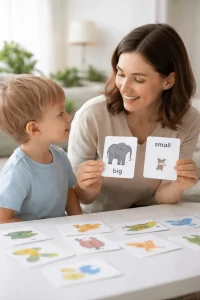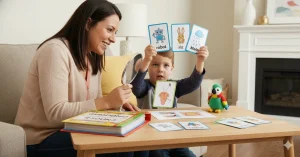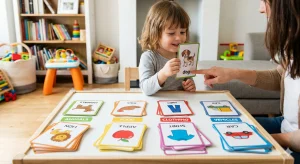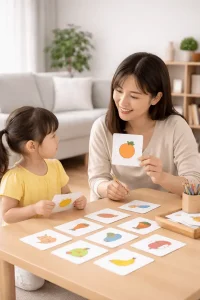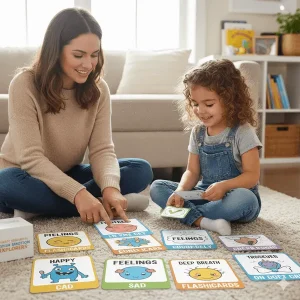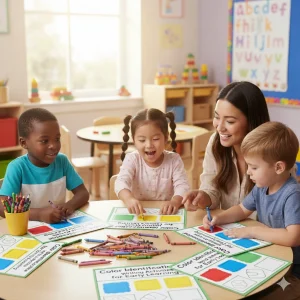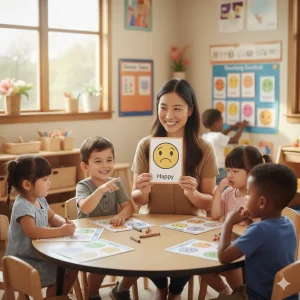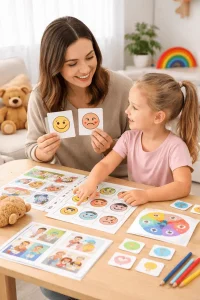Simple DIY Engagement Activities to Combat Still Face Syndrome
By Wellness Hub
Last Updated: October 8, 2024
Imagine you’re playing peek-a-boo with your baby, making faces, and getting those priceless giggles in return. Now, imagine doing the same thing, but this time your face is expressionless—no smiles, no reactions. How would your little one respond? This scenario captures the essence of Still Face Syndrome, which can impact a child’s emotional development in subtle but significant ways. If you’re a parent or caregiver, you might wonder how to keep your child emotionally engaged in a fun and natural way. Let’s dive into this together.
Understanding Still Face Syndrome
What Is Still Face Syndrome?
Imagine this: you’re playing with your baby, making funny faces, laughing together, and suddenly, you stop reacting. You keep your face still—no smile, no laughter, no emotion. Your child might look at you confused, try to get your attention, and when there’s no response, you’ll notice their mood change—they may frown, turn away, or even cry. This is a snapshot of what happens in Still Face Syndrome.
Still Face Syndrome refers to a scenario where a parent or caregiver unintentionally gives a “still” or unresponsive face during interactions. When a parent shows little to no emotion or responsiveness, it creates a situation where the child struggles to understand or connect emotionally. For babies and young children, facial expressions are a vital way to learn about emotions, social cues, and communication. If a child doesn’t receive these emotional responses, they may experience stress and can feel neglected, which can impact their emotional and social growth.
For example, consider a baby playing with their mom. The mom usually smiles back when the baby laughs or makes noises. Now, if the mom suddenly stops smiling and doesn’t react, the baby might feel confused, frustrated, or even scared because they’re not getting that emotional feedback they depend on.
Also Read: Identifying and Managing Still Face Syndrome in Children
Why Emotional Engagement Is Important
You might wonder why these little moments of emotional interaction are such a big deal. Well, think of these interactions as “brain food.” Emotional engagement is crucial for brain development, social skills, and overall emotional health. When you smile at your child, make eye contact, or play together, you’re doing more than just having fun—you’re actually helping their brain grow and learn.
Research shows that when a child experiences warm, responsive interactions, their brain creates stronger connections. These connections help them understand emotions, recognize facial expressions, and learn how to communicate. Emotional bonding activities are essential in teaching your child about the world, helping them to feel safe and secure.
But what happens when emotional engagement is lacking? If a child regularly experiences “still face” interactions—where there’s little response or connection—they may face difficulties in developing social skills, emotional regulation, and even self-confidence. Over time, this can lead to behavioral issues, anxiety, or difficulty forming relationships.
Emotional Development Milestones
| Age Range | Emotional Milestones |
|---|---|
| 0-3 Months | Begins to recognize caregivers, responds to soothing sounds, smiles in response to familiar faces and voices (social smile). |
| 3-6 Months | Starts to coo, babble, and make different sounds to communicate; begins to laugh and show excitement during play. |
| 6-9 Months | Responds to facial expressions and tone of voice; imitates sounds and gestures (e.g., waving, clapping); enjoys interactive games like peek-a-boo. |
| 9-12 Months | Develops stronger preferences for familiar people; may show anxiety around strangers (stranger anxiety); uses simple gestures like pointing or reaching out to communicate needs. |
| 1-2 Years | Demonstrates a wider range of emotions (e.g., joy, anger, frustration); seeks comfort from caregivers when upset; begins to show affection through hugs, kisses, and cuddles. |
| 2-3 Years | Shows signs of empathy (comforts others when they are sad); engages in simple pretend play; starts to understand turn-taking and sharing in play with peers. |
| 3-4 Years | Expresses complex emotions like pride, embarrassment, or jealousy; seeks approval from caregivers; enjoys cooperative play with other children and begins to develop friendships. |
| 4-5 Years | Can identify their own emotions and those of others; begins to manage emotions more effectively; uses language to express feelings and resolve conflicts. |
| 5-6 Years | Develops a sense of self-esteem and self-awareness; understands rules in games and social interactions; demonstrates an ability to wait their turn and consider others’ perspectives. |
Building a Strong Emotional Bond
The good news is that simple DIY activities can make a big difference. Spending time engaging in emotional, face-to-face play with your child can prevent still face syndrome and enhance their overall development. By being present, playful, and emotionally responsive, you’re giving your child the foundation they need for healthy emotional growth.
Also read: 5 Early Signs of Still Face Syndrome You Need to Know
Signs Your Child May Need More Emotional Engagement
As a parent or caregiver, you’re the best person to notice if your child may need a little more emotional connection. But how can you tell? There are some common indicators that your child might not be getting the level of emotional engagement they need. Recognizing these signs early can help you step in and create those crucial bonding moments. Let’s look at some of these signs together.
Common Indicators of Emotional Detachment
1. Decreased Eye Contact
If your child avoids eye contact or seems to look away when you try to interact with them, it might be a sign they are not feeling emotionally connected. Babies and young children naturally seek eye contact to communicate and bond with you. When it’s missing, it may indicate that they’re feeling emotionally distant.
2. Lack of Response to Your Expressions
Does your child light up when you smile at them, or do they seem indifferent? If your child shows little to no reaction to your facial expressions, such as smiles, funny faces, or animated gestures, it could mean they’re struggling to engage emotionally. Children usually respond to their parents’ expressions with interest or mimicry, so a lack of response is worth noting.
3. Withdrawal or Quietness During Play
Pay attention to how your child behaves during playtime. If they seem withdrawn, quiet, or uninterested in playing with you or others, it could be a sign that they need more emotional engagement. Play is an important way for children to connect and learn, so disengagement can indicate they’re not receiving the emotional stimulation they need.
4. Frustration, Irritability, or Tantrums
When a child feels emotionally disconnected, it can lead to frustration. You may notice increased irritability or more frequent tantrums, especially when trying to engage with them. While all children experience mood swings, consistent frustration without a clear reason might indicate they are struggling to feel emotionally secure.
5. Difficulty Calming Down
Another sign to look for is if your child has trouble self-soothing or calming down after getting upset. A well-engaged child typically learns to regulate their emotions through their caregiver’s cues. If your child seems to have difficulty finding comfort, they might not be experiencing the level of emotional engagement they need.
6. Limited Verbal or Non-Verbal Communication
Even before children start talking, they use a lot of non-verbal cues like babbling, pointing, or gesturing. If your child is not using these forms of communication or seems quieter than usual, it might be a sign of emotional detachment. Encouraging these small interactions can greatly enhance your emotional connection.
Becoming Aware as a Parent
It’s natural to feel worried if you notice any of these signs in your child, but the good news is that simply becoming aware of these cues is a big step forward. By being more observant during your everyday interactions—whether it’s playtime, mealtime, or even when you’re out on a walk—you can start to identify the moments when your child is craving more emotional engagement.
The key is to be present and responsive. When your child looks at you, respond with a smile. When they reach out to you, be there with a gentle touch. And if they’re showing any signs of frustration or withdrawal, take a moment to understand what they might need emotionally.
Simple DIY Engagement Activities
As parents, we often look for ways to connect with our children. The good news is that building a stronger bond doesn’t require any fancy materials or complex setups. You can do these simple, effective activities right in your living room, using everyday items. Not only are they easy to implement, but they also create valuable emotional connections that help prevent Still Face Syndrome and boost your child’s emotional development.
Activity 1: Peek-a-Boo and Imitation Games
Why: Peek-a-boo is a classic game that never gets old, especially for babies and toddlers. It helps build emotional connections, trust, and surprise—essential components of social engagement. Imitation games, where you copy your child’s expressions and movements, help them feel seen and understood.
How to Do It:
- Peek-a-Boo: Cover your face with your hands or a cloth and then dramatically “reappear” with a smile or silly expression. The anticipation of the reveal is what makes it so fun for your little one. Try changing your expressions every time—happy, surprised, silly—and see how your child reacts.
- Imitation Games: If your child claps, clap back. If they stick out their tongue, you do it too! This mimicking behavior helps them feel understood and encourages them to initiate more interactions.
Activity 2: Mirror Play
Why: Mirror play enhances self-recognition, social bonding, and allows for a deeper understanding of facial expressions. It’s a great way for your child to explore their own emotions and connect with you at the same time.
How to Do It:
Sit in front of a mirror with your child on your lap. Make different facial expressions like smiling, frowning, or raising your eyebrows and encourage your child to mimic what they see. You can also make a game of it by playing “Who can make the silliest face?” This helps them explore different emotions and see how expressions change.
Activity 3: Sensory Play with Homemade Items
Why: Sensory play is fantastic for engaging multiple senses and creating shared experiences. The textures, sounds, and sights your child experiences can spark curiosity and joy, making it a great bonding activity.
How to Do It:
- Use everyday household items to create simple sensory experiences. For instance, you can make homemade playdough with flour, water, and food coloring. Let your child squish, mold, and explore it.
- For water play, fill a small container with water and let your child splash around with cups or sponges. You can even add a few drops of essential oil for a relaxing scent.
- Dry pasta, rice, or beans also make for great sensory bins. Let your child scoop, pour, or simply feel the textures.
Activity 4: Reading with Emotional Expression
Why: Reading to your child is more than just a way to pass time—it’s a powerful tool for building emotional awareness and improving communication. When you read with animated voices, expressions, and gestures, it turns Storytime into a lively, bonding experience.
How to Do It:
Choose a fun storybook, sit with your child, and read with lots of energy. Use different voices for each character and let your facial expressions match the story’s emotions—be happy, surprised, or even a bit scared. Encourage your child to point to pictures, laugh along, or repeat phrases. It’s a great way to teach them about emotions and language while having fun together.
Activity 5: Music and Movement
Why: Music and movement are natural ways for children to express themselves physically and emotionally. Dancing, singing, or creating simple musical instruments together can bring out joy and help you connect on a deeper level.
How to Do It:
- Dance Party: Put on your child’s favorite song and dance around the room together. There are no rules—just have fun and move however you like.
- Singing Together: Sing simple nursery rhymes or make up songs about what you’re doing, like “brushing our teeth” or “tidying up toys.”
- DIY Instruments: Make shakers by filling a small container with rice or beans and sealing it. Then shake along to the music or create your own rhythm!
Activity 6: Simple Art and Craft Projects
Why: Art and craft activities allow your child to express their creativity and emotions. It’s also a great way to bond through shared experiences and celebrate their little creations.
How to Do It:
- Finger Painting: Lay out some paper and let your child explore with washable paints. Finger painting is great for sensory play and creative expression.
- Handprints and Footprints: Use paint to create handprint or footprint art. It’s messy, but loads of fun and can be a keepsake to look back on later.
- Storyboards: Cut out pictures from old magazines or print out some from online, and create a story with your child using glue and paper. Ask them to describe the pictures and help them weave together a fun story.
Tips for Enhancing Emotional Engagement During Activities
You’ve got the activities, and you’re ready to start creating those precious emotional moments with your child. But how can you make sure these interactions truly deepen your bond and prevent Still Face Syndrome? Here are some simple tips to make the most out of your playtime together.
1. Be Fully Present
In a world full of distractions, being truly present with your child can sometimes be challenging—but it’s worth it. When you engage in an activity together, give your child your full attention. This means putting away your phone, turning off the TV, and setting aside any distractions. Your child is more likely to respond positively and feel connected when they know you’re genuinely engaged with them.
Tip: Create a “distraction-free zone.” It can be as simple as setting a rule that no screens are allowed during playtime. A small effort goes a long way in fostering a secure emotional connection.
2. Use Positive Reinforcement
Children thrive on positive feedback. When they see that their actions are met with a smile, a cheer, or a simple “Well done!”, they feel appreciated, valued, and emotionally connected. Positive reinforcement encourages your child to continue exploring and engaging with you, making them feel secure in the relationship.
How to Do It:
- Smile warmly when they look at you.
- Clap your hands or give a high-five when they do something new or fun.
- Use encouraging words like “Great job!” or “You’re so creative!” to boost their confidence.
3. Keep a Routine
Children find comfort in routines, and setting a regular time for bonding activities can make your child feel secure and loved. By engaging in emotional bonding activities consistently, you help establish a predictable environment where your child knows they can count on your attention and care.
Tip for Busy Parents:
- Choose a time that works for both of you. It could be right after breakfast, before bedtime, or during a quiet moment in the afternoon.
- Even short sessions matter—5 to 10 minutes of fully present, emotionally engaging playtime every day can make a big difference.
Conclusion
Incorporating simple DIY activities into your routine can greatly enhance your child’s emotional engagement and overall development. Whether it’s a playful game of peek-a-boo or sharing silly expressions in front of the mirror, these moments nurture emotional bonds and safeguard against Still Face Syndrome. The best part? It only takes a few minutes of your undivided attention. Start with one activity today and watch as your child’s social skills and emotional well-being blossom. Remember, small efforts lead to big results. Connect with us at Wellness Hub for more tips, guidance, and resources to support your child’s growth.
Frequently Asked Questions:
1. What is Still Face Syndrome and why should I be concerned?
Still Face Syndrome refers to a situation where a child experiences emotional distress due to a lack of facial expressions or reactions from their caregiver. It’s important to address because emotional engagement plays a critical role in your child’s social, emotional, and cognitive development.
2. How do I know if my child needs more emotional engagement?
Some signs that your child may need more emotional engagement include avoiding eye contact, a lack of response to your facial expressions, being withdrawn or quiet during play, frequent irritability, and difficulty calming down. Regularly engaging in interactive play can help address these signs.
3. Can DIY activities really help prevent Still Face Syndrome?
Yes! Simple DIY activities like peek-a-boo, mirror play, and sensory games can encourage emotional responses and bonding between you and your child. These activities make them feel seen, heard, and understood, which is crucial for preventing emotional detachment.
4. How much time should I spend on these bonding activities each day?
Even 5 to 10 minutes of fully engaged playtime each day can have a significant impact on your child’s emotional well-being. The key is consistency, so try to integrate these bonding moments into your daily routine.
5. What are some examples of easy DIY emotional engagement activities?
Some easy activities include playing peek-a-boo, making faces in front of a mirror, reading with animated expressions, dancing together to music, or creating simple crafts like finger painting. All of these activities can help strengthen emotional connections.
6. Can I use everyday household items for sensory play with my child?
Absolutely! Everyday items like water, rice, pasta, homemade playdough, or even fabric scraps can be used for sensory play. These simple activities are great for engaging your child’s senses and encouraging shared play experiences.
7. How can I make sure I’m fully present during playtime?
To be fully present, set aside distractions like your phone or TV and focus on your child. Make eye contact, smile, and respond to their actions. Creating a routine for playtime can also help you stay consistent and make these bonding moments a regular part of your day.
8. Why is emotional engagement so important for my child’s development?
Emotional engagement is essential for your child’s brain development, social skills, and emotional regulation. By engaging in interactive play, you help them build confidence, understand emotions, and learn how to communicate better.
9. How do I encourage my child to interact more during these activities?
Encourage your child by using positive reinforcement. Smile, cheer, and celebrate their efforts, no matter how small. Let them take the lead, and be patient—your responsiveness will make them feel more comfortable and eager to engage.
10. Where can I find more resources on emotional engagement activities?
For more ideas and resources on enhancing your child’s emotional well-being, you can visit Wellness Hub’s home therapy resources. We provide various suggestions and tips to support your journey in building a strong emotional bond with your child.
About the Author:
Shravanaveena Gajula
M.Sc ., Speech and Language Pathology (9+ years of experience)
Shravanaveena Gajula is a dedicated Audiologist and Speech-Language Pathologist with a BASLP and an M.Sc in Speech and Language Pathology. With experience spanning multiple settings, including Wellness Hub and Ashray Akruti, Veena specializes in a wide range of disorders from developmental issues in children to speech and language assessments in adults. Her expertise includes parent counseling, managing speech sound and fluency disorders, and creating individualized therapy programs. Veena is also PROMPT certified and an author of several insightful blogs on speech and language pathology, aiming to educate and assist caregivers in supporting their loved ones.
Book your Free Consultation Today
Parent/Caregiver Info:
Client’s Details:
* Error Message
